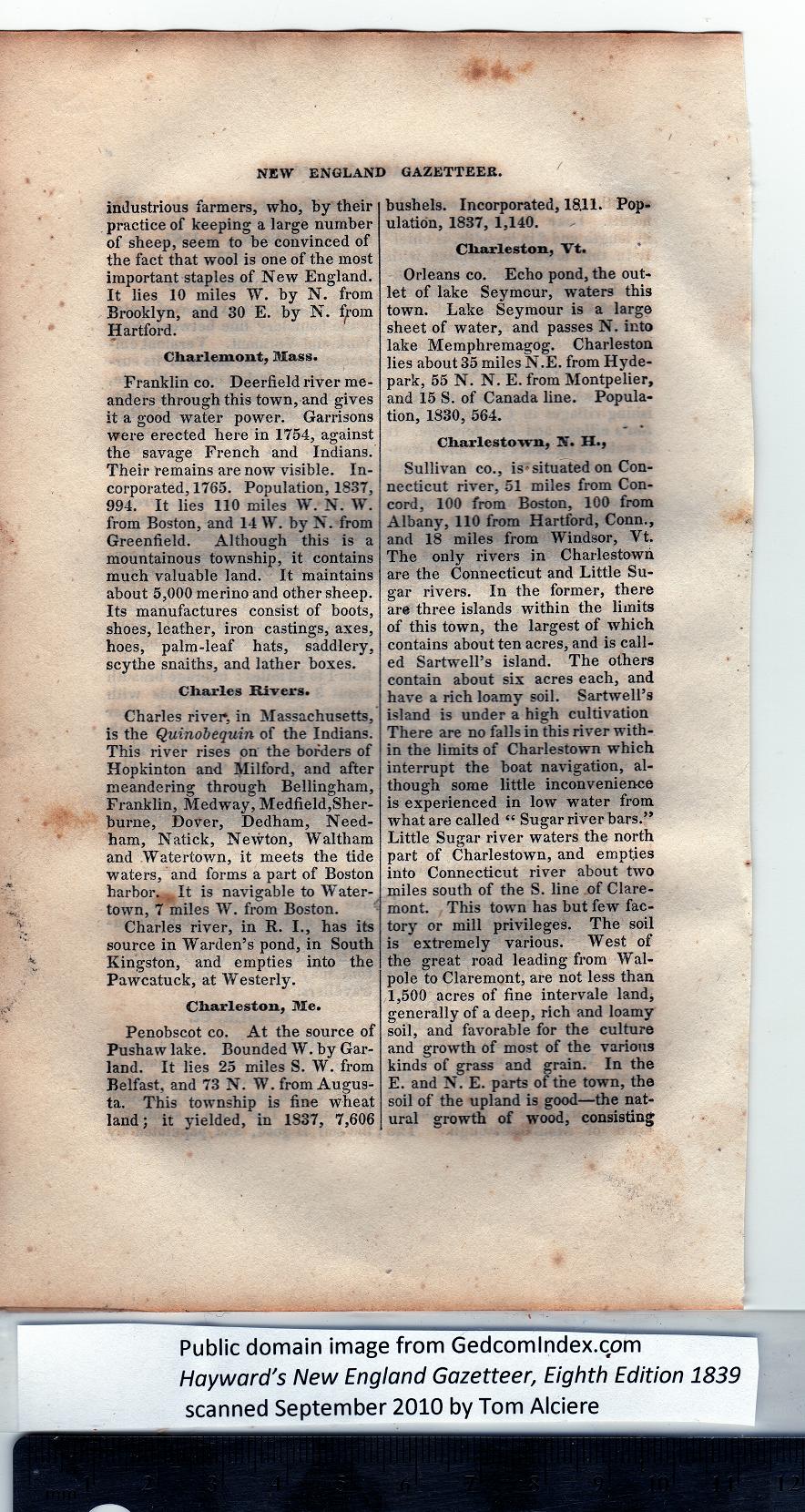|
industrious farmers, who, by their
practice of keeping a large number
of sheep, seem to be convinced of
the fact that wool is one of the most
important staples of New England.
It lies 10 miles W. by N. from
Brooklyn, and 30 E. by N. from
Hartford.
Charlemont, Mass.
Franklin co. Deerfield river me-
anders through this town, and gives
it a good water power. Garrisons
were erected here in 1754, against
the savage French and Indians.
Their remains are now visible. In-
corporated, 1765. Population, 1837,
994. It lies 110 miles W. N. W.
from Boston, and 14 W. by N. from
Greenfield. Although this is a
mountainous township, it contains
much valuable land. It maintains
about 5,000 merino and other sheep.
Its manufactures consist of boots,
shoes, leather, iron castings, axes,
hoes, palm-leaf hats, saddlery,
scythe snaiths, and lather boxes.
Charles Rivers.
Charles river, in Massachusetts,
is the Quinobequin of the Indians.
This river rises on the borders of
Hopkinton and Milford, and after
meandering through Bellingham,
Franklin, Medway, Medfield,Sher-
burne, Dover, Dedham, Need-
ham, Natick, Newton, Waltham
and Watertown, it meets the tide
waters, and forms a part of Boston
harbor. It is navigable to "Water-
town, 7 miles W. from Boston.
Charles river, in R. I., has its
source in Warden’s pond, in South
Kingston, and empties into the
Pawcatuck, at Westerly.
Charleston, Me.
Penobscot co. At the source of
Pushaw lake. Bounded W. by Gar-
land. It lies 25 miles S. W. from
Belfast, and 73 N. W. from Augus-
ta. This township is fine wheat
land; it yielded, in 1837, 7,606
bushels. Incorporated, 18.11. Pop-
ulation, 1837, 1,140. |
Charleston, Vt.
Orleans co. Echo pond, the out-
let of lake Seymour, waters this
town. Lake Seymour is a large
sheet of water, and passes N. into
lake Memphremagog. Charleston
lies about 35 miles N.E. from Hyde-
park, 55 N. N. E. from Montpelier,
and 15 S. of Canada line. Popula-
tion, 1830, 564.
Charlestown, N. H.,
Sullivan co., is? situated on Con-
necticut river, 51 miles from Con-
■ cord, 100 from Boston, 100 from
Albany, 110 from Hartford, Conn.,
and 18 miles from Windsor, Vt.
The only rivers in Charlestown
are the Connecticut and Little Su-
gar rivers. In the former, there
are three islands within the limits
of this town, the largest of which
contains about ten acres, and is call-
ed Sartwell’s island. The others
contain about six acres each, and
have a rich loamy soil. Sartwell’s
island is under a high cultivation
There are no falls in this river with-
in the limits of Charlestown which
interrupt the boat navigation, al-
though some little inconvenience
is experienced in low water from
what are called “ Sugar river bars.”
Little Sugar river waters the north
part of Charlestown, and empties
into Connecticut river about two
miles south of the S. line of Clare-
mont. This town has but few fac-
tory or mill privileges. The soil
is extremely various. West of
the great road leading from Wal-
pole to Claremont, are not less than
1,500 acres of fine intervale land,
generally of a deep, rich and loamy
soil, and favorable for the culture
and growth of most of the various
kinds of grass and grain. In the
E. and N. E. parts of the town, the
soil of the upland is good—the nat-
ural growth of wood, consisting |
